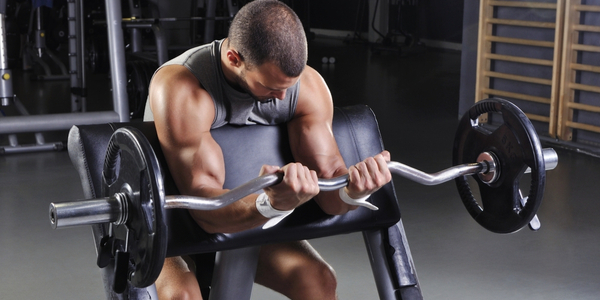The biceps and triceps are some of the most popular muscle groups to train, and that comes to no surprise. After all, if you ask most regular gym goers about their goals and intentions for training, then you’ll typically hear something along the lines of “wanting nice arms” sitting close to the top of their list. In this article, we’re going to talk about a powerful and under utilized training tool for the biceps and triceps — heavy eccentrics/negatives.
One of the beautiful things about training the biceps and triceps is that there are so many different ways to do so and the only real cap for growth comes down to one’s creativity. This training methodology is simple in nature and can be implemented in multiple ways, which makes it a dynamic training option for every fitness level.
[How often should you train the arms? Guidelines for every fitness goal and level!]

What Are Eccentrics?
Eccentrics, also referred to as negatives, are a type of a training that focus on the lengthening of a muscle or muscle group. As opposed to working through a full range of motion — a.k.a the lifting and lowering phases — with eccentrics the only focus is on the lowering portion of an exercise.
A few examples in practice with arm training include:
- The lowering portion in the biceps curl.
- The lowering portion in the dip.
- The upward motion in the triceps extension.
Remember, the biceps flex the arms and the triceps extend them, so if you’re ever confused about a movement and which action is its eccentric, then look at the elbow and note which muscle is being lengthened when contracting.

What Are the Benefits of Negatives?
Why use eccentric focused exercises for arms? Let’s look at some of the benefits that come along with this style of training.
1. Provide Overload Stimulus
When shortening a muscle there will always be a cap on the amount of force that can be produced to lift an external load. For example, you can only lift so much due to the natural strength curve of an exercise and how much force a muscle is capable of producing at any given time.
However, in the eccentric phase, muscle has a greater potential to produce force and this has been suggested due to the increased amount of cross bridges formed due to its lengthening. Studies have suggested that the body is able to produce roughly 1.8x more force with the use of eccentrics suggesting eccentrics to be a useful tool for providing an overload stimulus on the arms. (1)
Think about a dumbbell preacher curl. When concentrically contracting you can only lift so much due to leverage and strength. Yet, if you only complete the lowering portion of the exercise, then you can load the biceps with much more weight providing them with an overload stimulus.

2. Useful for Body Awareness
This is an experiential benefit, but loading and actively teaching the body how to contract throughout eccentrics is an incredibly powerful tool. Since most eccentrics are performed with tempos and (often) heavier weight, then they’re a great tool for trying to practice building a strong mind muscle connection.
By increasing time under tension and slowing things down, you’ll have more time to focus on the activity at hand and practicing the skill of eccentrically loading, which can have carryover to other activities.
3. Improve Tenacity of Surrounding Tissues
When performed sparingly and strategically, tempo and heavy eccentric work can also be a useful tool to strengthen tendons and ligaments surrounding certain joints. By loading the joints in a controlled fashion with heavy weight, you can improve the integrity of the tendons by supporting their ability to hold heavier loads.
For example, lifters with elbow discomfort during traditional elbow flexion exercises can use eccentrics to provide the arms with a stimulus and to continue training pain free.
How to Program Eccentrics/Negatives
There are handfuls of ways to program eccentrics (negatives) in a program and you can be as creative as you’d like with them. However, it’s worth noting that the use of eccentrics, especially with supamaximal loads, should have strategy behind and rationale behind the loading.
Eccentric Program Considerations
Before diving into three ways you can start programming eccentrics/negatives for your arm training, let’s quickly go over a few considerations to keep in mind so you can program individually for your goals and needs.
- Progress Slowly: Heavy eccentrics are a different stimulus for what most trainees are used to, so treat them like every other exercise variation that is new to a program and ease into their use. Integrate a set in, then progressively overload them slowly by adding one of the following A) more volume, B) weight, or C) additional tempo.
- Consider the Movement: Personally, I love using eccentrics for arms when I’m working on a fixed surface and I don’t have a training partner. For example, using them for preacher curls and curls with the back against the wall. By having the fixed surface, you can really focus on spending all of your energy on the consideration of the eccentric loading pattern and you can help yourself bring the weight back up.
- Energy Use: If your main focus is on strength for traditional exercises, then use eccentrics sparingly at the beginning of your training solely to use the focal point of your energy towards your main goal at hand. Conversely, if your goal is time under tension and overloading the arms, then start with eccentrics — be mindful of your energy allotment.
1. Top Set Tempo Work
If you’re performing isolation arm exercises on a fixed surface, then adding a top set of eccentrics is a fantastic way to overload the arms when fatigued while trying to control soreness and fatigue. This is also a useful strategy for eccentric training beginners who haven’t programmed a ton of this form of training in their programs before.
- Why: Acclimate to eccentric training and control fatigue.
Example: Preacher Curl | 3 x 8 ea arm + top set 1 x 5 ea arm eccentrics
Top Set Example: 1 x 5 eccentrics with a tempo of 6-seconds completed with 5-10 lbs heavier weight than completed with on the final set. So if you finished your final set of preachers with 35 lbs, then you would use 40-45 lbs for your top eccentric set.
2. Full Sets
As opposed to only doing one set, you can program full sets with eccentric work. This is a useful strategy for folks who need variation in their training, but also those who might be experiencing elbow discomfort. For example, if the elbows flare up after longer arm workouts, then try adding eccentric sets in when you feel the potential limitation of discomfort start.
- Why: Prolong arm workouts and provide variation to training.
Example: Triceps Extension | 3 x 12 with 5-second eccentric.
3. Burnout Sets
Eccentrics can also be an incredible tool when programming burnout work at the end of workouts. If the goal is increasing time under tension with a controlled stimulus, then using eccentrics is an easy way to increase time under tension.
When using burnout eccentrics to failure, you’ll likely need a training partner present to help assist you with repositioning yourself after hitting the end range of motion. For example, if you’re using skull crushers like the example below, then you’ll likely want a friend to help you bring the weight up from the end range of motion to the starting position.
- Why: Useful tool for increasing time under tension with sets to failure.
Example: Dumbbell skull crushers | 2 x failure with 6-second eccentric
Wrapping Up
Using eccentrics/negatives for arm workouts are a fantastic way to vary your training and change up the stimulus you’re providing them. If your biceps and triceps are growing stubbornly slow, then try integrating in some eccentric work slowly into your program and track your progress!
Eccentric/Negative Training FAQs
What is eccentric training?
Eccentric training entails only performing the lower portion of exercises and giving one’s full attention to muscle contraction while it’s lengthening. This style of training is great for providing the body with variation and when focusing on overloading a muscle or muscle group.
What are negatives?
Negatives are another way to refer to eccentric training. Basically, you’re only performing and focusing on the “negative” portion of an exercise, a.k.a. the lengthening and lowering portion of a movement.
What are the benefits of negatives?
Besides providing variation and a different form of stimulus for muscles, negatives come with a few fantastic benefits including:
- Great for helping muscles produce more force through the use of eccentric loading.
- Improve integrity of surrounding tissues of a muscle group.
References
1. Hody, S., Croisier, J. L., Bury, T., Rogister, B., & Leprince, P. (2019). Eccentric Muscle Contractions: Risks and Benefits. Frontiers in physiology, 10, 536.
Feature image from Dave Kotinsky / Shutterstock